2010 SRX turbo - Interior and Electronics
Part 1 - OverviewPart 2 - Our test carPart 3 - Exterior and DesignPart 4 - Interior and ElectronicsPart 5 - Ride and Performance
Image galleries - SRX Review Pics | SRX Pics from Cadillac
It is important to note how we approach an evaluation of electronics in any car - to put not too fine a point on it, we're demanding. In this world of top-notch consumer electronics, it is unacceptable for any automaker to put a product out that is clunky to use, doesn't do what it needs to do with minimum study of the owners manual, and/or isn't completely intuitive to use.
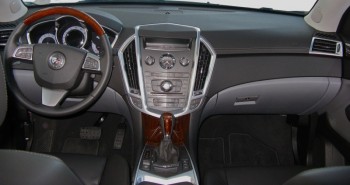 We spent a week with the SRX and it had every electronic goodie that it could have. So, this allowed evaluation of every feature and, given the relatively short time we were with the car, highlighted any features that were not immediately easy to use. A long-term owner might find some of these annoyances fade with time, but we won't make that assumption here.
Most of our complaints (and really, our only complaints about the SRX as a whole) center around the electronic features - not that they don't work, just that they could be better at what they do - but first, let's go over the interior itself. As expected of any Cadillac, this is a nice place to spend some serious seat time.
Seating arrangements
Unlike the previous SRX, which was a 3-row capable vehicle (though the 3rd row was not standard on the base trim), the new SRX is 2 rows only. This allows for a shorter overall package and also gives the new vehicle a less wagon-y set of proportions - matching its new SUV/Crossover position.
We spent a week with the SRX and it had every electronic goodie that it could have. So, this allowed evaluation of every feature and, given the relatively short time we were with the car, highlighted any features that were not immediately easy to use. A long-term owner might find some of these annoyances fade with time, but we won't make that assumption here.
Most of our complaints (and really, our only complaints about the SRX as a whole) center around the electronic features - not that they don't work, just that they could be better at what they do - but first, let's go over the interior itself. As expected of any Cadillac, this is a nice place to spend some serious seat time.
Seating arrangements
Unlike the previous SRX, which was a 3-row capable vehicle (though the 3rd row was not standard on the base trim), the new SRX is 2 rows only. This allows for a shorter overall package and also gives the new vehicle a less wagon-y set of proportions - matching its new SUV/Crossover position.
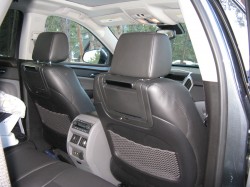 Front seats appear to be one of the components straight out of the Epsilon II parts bin (appearing to be identical to those in the Buick Lacrosse. They are firm (more so than a traditional Cadillac buyer may expect or like), though not overly so, and are comfortable on longer trips. In our Premium package, we had both seat heat and cooling, power adjustments with memory for two drivers, and the driver's seat had a manually adjustable thigh support.
Front seats appear to be one of the components straight out of the Epsilon II parts bin (appearing to be identical to those in the Buick Lacrosse. They are firm (more so than a traditional Cadillac buyer may expect or like), though not overly so, and are comfortable on longer trips. In our Premium package, we had both seat heat and cooling, power adjustments with memory for two drivers, and the driver's seat had a manually adjustable thigh support.
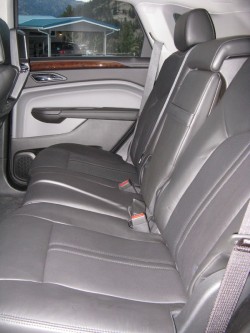 Rear seating was similarly comfortable with heat (no cooling function back here). Here you find the typical 60/40 split fold as well as a ski pass-through in the folding arm-rest. Rear-seat entertainment is mounted to the upper-back of the front seat and compromises the feeling of space for seated riders and, for those of you with a little one in a car-seat, can make things a little tight for their legs. Our 18-month old was able to easily put her feet on the surround for the rear-screen, so be forewarned. The rear seat also has 2-positions for the seat back though I can't imagine any adults would willingly choose the more upright position as it exaggerates any feeling of being too close to the front seatback.
Running the length of the interior is Cadillac's signature UltraView roof. Consisting of a full-length retractable sun shade (fully opaque, so you can pretend that you don't have a giant window over the entire seating area), as well as a tilt and retract glass panel over the front seats and a fixed glass over the rear row. The ability to let the sun shine in certainly lightens up the interior and brightened the mood of our dark interior significantly.
Cargo area
Rear seating was similarly comfortable with heat (no cooling function back here). Here you find the typical 60/40 split fold as well as a ski pass-through in the folding arm-rest. Rear-seat entertainment is mounted to the upper-back of the front seat and compromises the feeling of space for seated riders and, for those of you with a little one in a car-seat, can make things a little tight for their legs. Our 18-month old was able to easily put her feet on the surround for the rear-screen, so be forewarned. The rear seat also has 2-positions for the seat back though I can't imagine any adults would willingly choose the more upright position as it exaggerates any feeling of being too close to the front seatback.
Running the length of the interior is Cadillac's signature UltraView roof. Consisting of a full-length retractable sun shade (fully opaque, so you can pretend that you don't have a giant window over the entire seating area), as well as a tilt and retract glass panel over the front seats and a fixed glass over the rear row. The ability to let the sun shine in certainly lightens up the interior and brightened the mood of our dark interior significantly.
Cargo area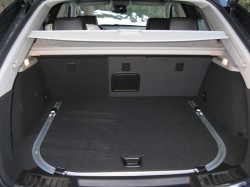 Behind the rear seat is a sizable cargo-hold with retractable cargo cover as well as (again in this trim - not available in the base SRX) cargo management system. The system consists of a flush track for tie-downs as well as a hidden storage well under the center area of the floor. We didn't exercise the full load-hauling abilities of our test car, but we saw no glaring design faults and expect that most owners will be happy with the ability to restrain items from grocery bags to the occasional bulky item.
Controls
Behind the rear seat is a sizable cargo-hold with retractable cargo cover as well as (again in this trim - not available in the base SRX) cargo management system. The system consists of a flush track for tie-downs as well as a hidden storage well under the center area of the floor. We didn't exercise the full load-hauling abilities of our test car, but we saw no glaring design faults and expect that most owners will be happy with the ability to restrain items from grocery bags to the occasional bulky item.
Controls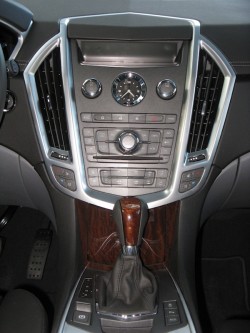 Now that we've discussed the overall layout, let's dive into the nitty-gritty of how you use the new SRX and what quirks we found.
First up in our mind are the door lock switches. Normal positioning on the door panel has been abandoned for switches in the center stack. This, on more than one occasion, left us hunting for how to let in someone when pulling up to them at the curb. This might get easier with time, but it isn't immediately obvious why these needed to be in a non-standard position.
As I mentioned earlier, we installed a child seat in our test car. If this review had been a few months later, we would have been interested in activating the rear door child lock-outs (the feature that prevents the interior door handle from opening the door - preventing an accidental opening by a child). On every car I've ever driven, these are physical switches you activate by opening the door and toggling the switch on the edge of the door itself. On the SRX, these have oddly been made electronic and are controlled by yet another switch in the center stack. With all the features the center stack is already controlling, did this need to be electrified? Is this truly a feature that people are turning on and off often enough for a more easily accessed switch to be a useful feature? I am thinking most people will wonder what this button even does without consulting the manual - a knock on the 'intuitive' scale for me.
Not unexpected in a modern luxury vehicle, but disappointing in a vehicle with performance intent, is the replacement of a physical parking brake lever with an electronic switch. However, this is certainly no worse than the foot-operated pedal we saw in the first generation CTS and SRX.
Now that we've discussed the overall layout, let's dive into the nitty-gritty of how you use the new SRX and what quirks we found.
First up in our mind are the door lock switches. Normal positioning on the door panel has been abandoned for switches in the center stack. This, on more than one occasion, left us hunting for how to let in someone when pulling up to them at the curb. This might get easier with time, but it isn't immediately obvious why these needed to be in a non-standard position.
As I mentioned earlier, we installed a child seat in our test car. If this review had been a few months later, we would have been interested in activating the rear door child lock-outs (the feature that prevents the interior door handle from opening the door - preventing an accidental opening by a child). On every car I've ever driven, these are physical switches you activate by opening the door and toggling the switch on the edge of the door itself. On the SRX, these have oddly been made electronic and are controlled by yet another switch in the center stack. With all the features the center stack is already controlling, did this need to be electrified? Is this truly a feature that people are turning on and off often enough for a more easily accessed switch to be a useful feature? I am thinking most people will wonder what this button even does without consulting the manual - a knock on the 'intuitive' scale for me.
Not unexpected in a modern luxury vehicle, but disappointing in a vehicle with performance intent, is the replacement of a physical parking brake lever with an electronic switch. However, this is certainly no worse than the foot-operated pedal we saw in the first generation CTS and SRX.
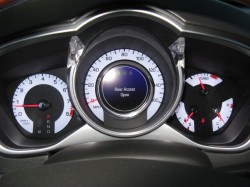 Turning our attention from the center stack for a few moments, we find one of the SRX's most interesting interior electronic gadgets...the Driver Information Center (DIC). This has been in Cadillacs for some time, but never as stylishly executed or as enjoyable to look at and use. Occupying the center of center most gauge pod, the display is full color and circular. It provides a wide array of information from tire pressure readings (listing the actual pressure of each tire), speed limit on the current road and information about the next turn when equipped with the nav system, etc. Switching from screen to screen is a simple twist of a ring on the stalk with your current position slate of screens denoted by a visual indication on a ladder of hash-marks on the display itself.
An interesting feature also located in the DIC is a representation of the 3 rear seat positions indicating which occupants are buckled. This helps parents keep tabs on if their rear passengers/children are buckled-up. This is one of those features that was likely very easy and inexpensive to implement and will likely sell a handful of SRX's to parents on its own.
See our video demo of the gauges in the SRX below:
Turning our attention from the center stack for a few moments, we find one of the SRX's most interesting interior electronic gadgets...the Driver Information Center (DIC). This has been in Cadillacs for some time, but never as stylishly executed or as enjoyable to look at and use. Occupying the center of center most gauge pod, the display is full color and circular. It provides a wide array of information from tire pressure readings (listing the actual pressure of each tire), speed limit on the current road and information about the next turn when equipped with the nav system, etc. Switching from screen to screen is a simple twist of a ring on the stalk with your current position slate of screens denoted by a visual indication on a ladder of hash-marks on the display itself.
An interesting feature also located in the DIC is a representation of the 3 rear seat positions indicating which occupants are buckled. This helps parents keep tabs on if their rear passengers/children are buckled-up. This is one of those features that was likely very easy and inexpensive to implement and will likely sell a handful of SRX's to parents on its own.
See our video demo of the gauges in the SRX below:
Then there are the things that don't work quite so well - lets go through our nits that we feel a need to pick:
- Headlights default to auto-mode at every startup, so I hope you don't like to choose when your lights come on by yourself as a rule
- When using the touch screen for nav or any of the 'infotainment' features - the interface places some on-screen buttons at the very bottom of the screen. This is adjacent to a horizontal 'shelf' of plastic below the screen forcing your hand into an awkward angle. Moving them up even a quarter inch would have helped quite a bit.
- Nav voice prompts were awful. This isn't uncommon on navigation systems, but when a $35 iPhone navigation app is significantly better at pronouncing street names...someone needs to go back to the drawing board.
- iPhone/bluetooth connectivity worked in our case (though we have heard other reviewers had difficulty getting iPhones to talk to the SRX's stereo through the connector in the center console (in the cargo well under the arm-rest).
- Voice dialing was just this side of unusable. Rather than providing a single button to activate voice-dial, the SRX's system requires a 3 step process to activate the phone's voice dialing feature (then leaving the phone to handle the recognition functions)...with that many steps, I'd find myself using the phone's keypad instead.
- Voice controls don't extend to control of the iPhone/iPod's music library - even though these features are available through the same in-phone voice recognition the system leverages for voice dialing.
Now, none of these might be a big deal to you - but Cadillac needs to realize that once the exterior styling is in place (which it fully is now), the interior materials and fit and finish are where they need to be (yep again), you are oh so close to success and attention is bound to turn to these sorts of quirks/failings and they are the last frontier to being all the way there.
It is in Cadillac's best interest to attack the human-machine interface as it relates to the electronic/entertainment features now rather than waiting for the rest of the industry to pass them by.
Navigation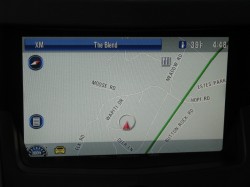 But, all isn't doom and gloom with the interior features - the basics are actually very strong (which makes the interface quirks all the more annoying). Take the navigation for instance. While nothing in any of the press materials or in the owners manual reference this, experience with other navigation solutions did highlight that this system actually learns with experience. When entering our home address to test navigation from work, it was obvious that it was way off on its ETA estimates...the first time. After the first trip on these roads, the system seems to have learned the actual average speeds, etc. and subsequent attempts to map this route resulted in spot-on ETA values. Nice.
Our SRX, as we mentioned before, had the dual-screen rear-seat entertainment system. The DVD slot is located up front and is controlled by either the front-seat passengers or by wireless remote by the rear seat passengers. Additionally, there are component inputs in the rear for plugging in portable entertainment devices. So, if your rear passengers are comfortable with the space in the rear of the SRX, they will certainly not be lacking for things to keep them occupied.
Back to the big, motorized screen up front is a feature that is becoming increasingly common in utility vehicles like the SRX. Drop the SRX into reverse and the front screen motors up and displays not only a clear view of what is behind, but also computer generated lines that are fed by the steering position sensor to show your trajectory. This system works well for backing into parking spaces and the guiding lines are quite accurate. With a bit of practice, I could envision doing the backup into a parking space bit without ever turning around.
Also helping in close-in/slow-speed maneuvers are the front and rear parking sensors that are also quite accurate at allowing you to position the SRX relative to other objects/cars. This is actually more helpful than you might first think given the high hood and relatively restricted view out the rear (a price you pay for the slick styling). Both make judging exact position fore/aft somewhat difficult.
...and that is the SRX interior in a nutshell.
So, thus far styling inside and out have been home runs with interior functions marred by a few items that Cadillac still isn't getting quite right.
So that leaves us with...'How does it drive?'.
Stay tuned for our last part of our SRX review where we tell you if you should pass on the new SRX or get down to your Cadillac dealer ASAP.
But, all isn't doom and gloom with the interior features - the basics are actually very strong (which makes the interface quirks all the more annoying). Take the navigation for instance. While nothing in any of the press materials or in the owners manual reference this, experience with other navigation solutions did highlight that this system actually learns with experience. When entering our home address to test navigation from work, it was obvious that it was way off on its ETA estimates...the first time. After the first trip on these roads, the system seems to have learned the actual average speeds, etc. and subsequent attempts to map this route resulted in spot-on ETA values. Nice.
Our SRX, as we mentioned before, had the dual-screen rear-seat entertainment system. The DVD slot is located up front and is controlled by either the front-seat passengers or by wireless remote by the rear seat passengers. Additionally, there are component inputs in the rear for plugging in portable entertainment devices. So, if your rear passengers are comfortable with the space in the rear of the SRX, they will certainly not be lacking for things to keep them occupied.
Back to the big, motorized screen up front is a feature that is becoming increasingly common in utility vehicles like the SRX. Drop the SRX into reverse and the front screen motors up and displays not only a clear view of what is behind, but also computer generated lines that are fed by the steering position sensor to show your trajectory. This system works well for backing into parking spaces and the guiding lines are quite accurate. With a bit of practice, I could envision doing the backup into a parking space bit without ever turning around.
Also helping in close-in/slow-speed maneuvers are the front and rear parking sensors that are also quite accurate at allowing you to position the SRX relative to other objects/cars. This is actually more helpful than you might first think given the high hood and relatively restricted view out the rear (a price you pay for the slick styling). Both make judging exact position fore/aft somewhat difficult.
...and that is the SRX interior in a nutshell.
So, thus far styling inside and out have been home runs with interior functions marred by a few items that Cadillac still isn't getting quite right.
So that leaves us with...'How does it drive?'.
Stay tuned for our last part of our SRX review where we tell you if you should pass on the new SRX or get down to your Cadillac dealer ASAP.
